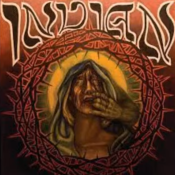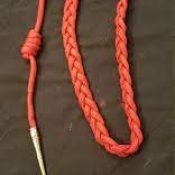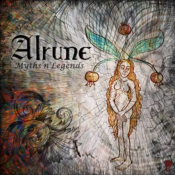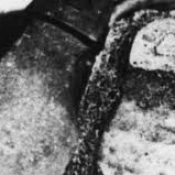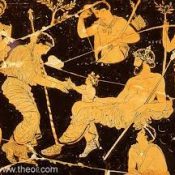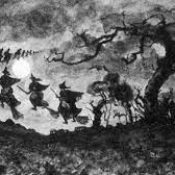Author: A Solitary Pagan
Essential Oils and Their Magickal Properties
ACACIA: Possessing high spiritual vibrations, this oil is worn to aid meditation and to develop psychic powers. Some also use it to anoint their altars, censers, and candles. ALL-SPICE: Very vitalizing. Gives added determination and energy, excellent for convalescents. Anoint daily. ALMOND: Almond oil, the symbol of wakefulness to the Egyptians, is used in prosperity rituals (anointing candles, mo...
Devil’s Marks
According to witch-hunters, the Devil always permanently marked the bodies of his initiates to seal their pledge of obedience and service to him. He marked them by raking his claw across their flesh or using a hot iron, which left a mark, usually blue or red, but not a scar. Sometimes he left a mark by licking them. The Devil supposedly branded witches at the end of initiation rites, which were pe...
Hermetica. Mystical Wisdom
Hermetica Forty-two sacred books of mystical wisdom attributed to the mythical Hermes Trismegistus, or“thrice great Hermes,” the combined Egyptian and Greek deities of Thoth and Hermes, respectively. The books, which date from somewhere between the third century b.c.e. and first century c.e., had an enormous impact on the development of Western occultism and magic. Many of the spells, rituals and ...
Allotriophagy
The vomiting or disgorgement of strange or foul objects, usually associated with someone possessed by or obsessed with the Devil or other demons. Such actions also once were seen as illusions or spells caused by witches or as attempts at suicide by the mentally deranged. Most treatises on possession written during the Renaissance and later included the vomiting of unusual objects as an indication ...
Airts, The Four
This is an old Gaelic term for the four points of the compass, north, south, east and west. They are important in magic, as the magic circle should always be orientated to them. Early Christian churches were also carefully orientated, with the high altar in the east; though in modern days this custom is not invariably observed, probably because present-day scarcity of land compels church architect...
Aiguillette
A knotted loop of thread, also called a ligature, which witches were said to use to cause impotence, and perhaps even castration, in men; barrenness in women; and general discontent in marriage. The aiguillette also served to bind couples in illicit amatory relationships. The phobia of the ligature, or fear of satanic castration, was widespread in 16th-century France. It was believed that at the i...
Alrunes
In German and Scandinavian myth, the Alrunes are sorceresses or female demons who can change shape; they are believed to be the mothers of the Huns. As late as the 19th century in some rural areas, they were personified by small statues, which were kept in the home, clothed and made offerings of food and drink. It was believed that the Alrunes could divine the future by responding to questions wit...
Footprints
Footprints are reputed to contain the essence of a person and may be used in magical charms and spells. Dust or dirt taken from a footprint may be used to obtain power over the person who made the print, just as clippings of hair and nails, bits of clothing, urine and excrement are believed to have magical potential. In the lore of Lithuania, footprint dirt buried in a graveyard will cause someone...
Baphomet
The symbol of the “sabbatic goat,” portrayed as a half-human, half-goat figure, or a goat head. The origin of the name Baphomet is unclear. It may be a corruption of Mahomet. The English witchcraft historian Montague Summers suggested it was a combination of two Greek words, baphe and metis, meaning “absorption of knowledge.” Baphomet has also been called the Goat of Mendes, the Black Goat and the...
Avalon, The Ancient British Paradise
Avalon, where the dying King Arthur found rest at the end of his epic story, has been identified with the present-day Glastonbury. Many legends cling to this ancient place, among the green hills of Somerset. Even today it is a land of enchantment. Rumours of witchcraft meetings at midnight on Glastonbury Tor have been current for many years. This was mentioned in Focus on the Unknown, by Alfred Go...
The Birth of Dionysus and the Twelve Days of Dionysos
In Orphic tradition the Nativity, Epiphany or birth (Genethlia) of Dionysus is celebrated in the evening of 24th December, and is the beginnng of 12 days of ritual worship of Dionysus the Saviour, and with each day one of the Olympian Gods (and their Divine Consorts) is also honoured. In Orphic myth, Dionysus has two (or three) births hence He is known variously as the Twiceborn (Digonon) or Thric...
Bune Wand
This is the old Scottish name given to anything a witch used to fly on. Contrary to popular belief, the instrument of the witches’ legendary flights through the air was by no means always a broomstick. The earliest accounts often refer to a forked wand, or simply a staff, which is given to the witch when she is initiated, together with a vessel of ointment, the witches’ unguent; and it is the latt...






